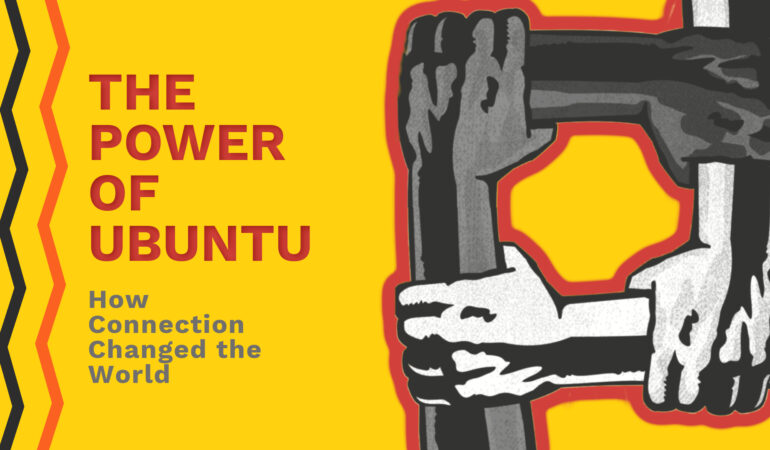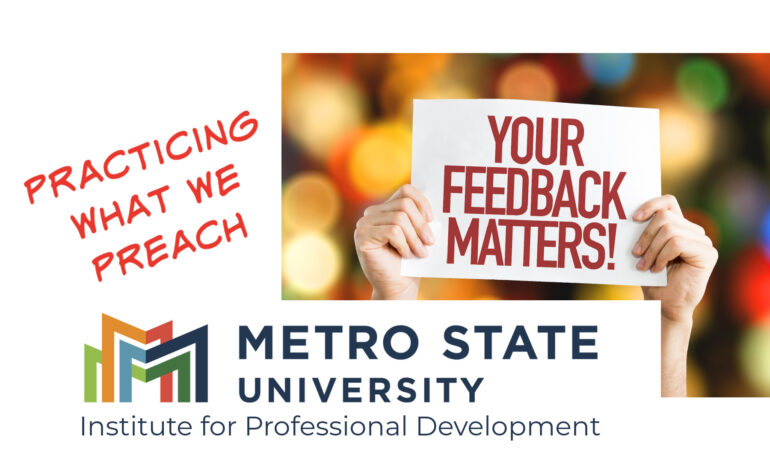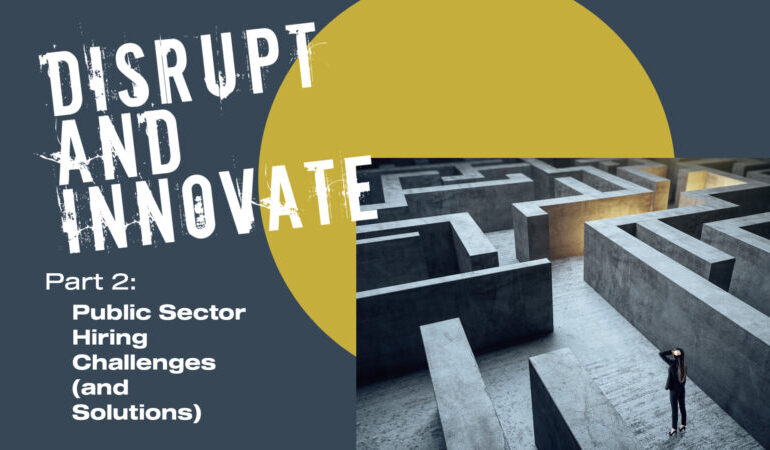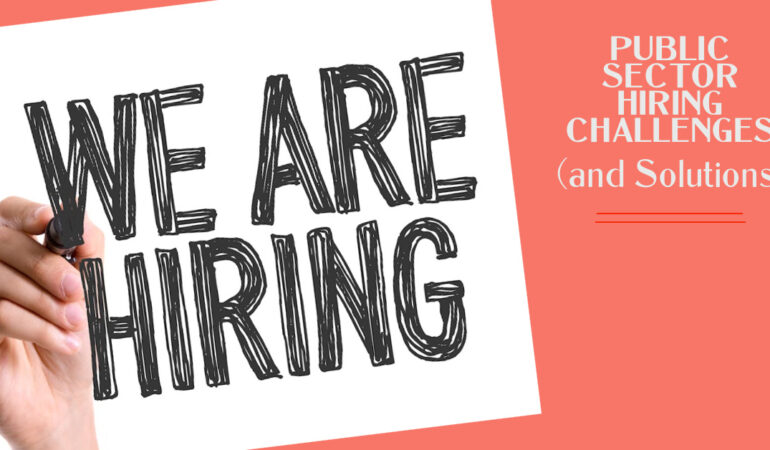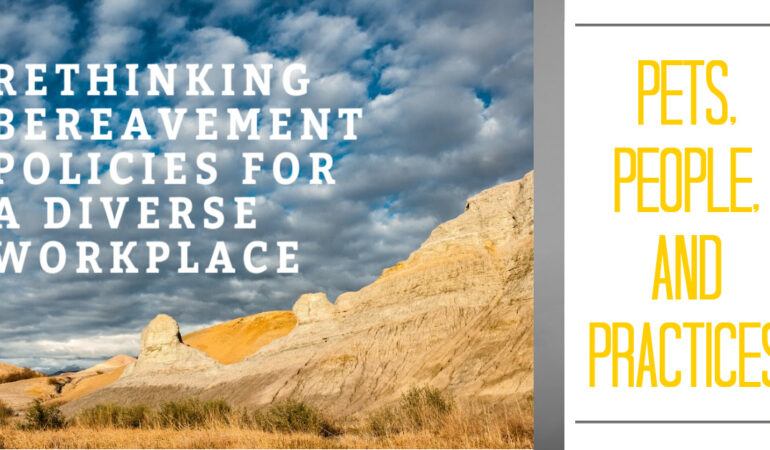The Power of Ubuntu: How Connection Can Change the World
By: Destyn Land
In American culture, we are often commended for our independence and ability to conquer tasks on our own. Our society values individualism, emphasizing personal freedom of speech, thought, and expression. While these ideals hold great power, it is equally vital to recognize the beauty that comes from embracing interdependence and the reciprocal nature of receiving help. However, this notion of interdependence can sometimes be overshadowed by our inherently individualistic mindset in the Western world. We must not consider this mindset as inherently negative, but rather as a different way of perceiving the world.
This is where the philosophy of Ubuntu comes into play. Originating from the Bantu people and the Nguni language of South Africa, Ubuntu embodies a set of values including caring, harmony, responsibility, compassion, reciprocity, connection, and continuity. Translated to “Humanity,” Ubuntu encapsulates the understanding that “I am because we are.” It entails looking beyond ourselves and acknowledging the connections between our lives and the lives of others.
Ubuntu challenges us to recognize that societal issues impact us all, of course in varying degrees. It teaches us to move beyond sympathy and into empathy, prompting us to take action. As the renowned Dr. Cornel West once paraphrased, empathy is not merely imagining someone else’s experiences but rather summoning the courage and will to do something about it. When we internalize the belief that “I am because we are,” we refuse to remain silent about the stories of marginalized individuals and the injustices they face. We reject the notion that we can continue with “business as usual” after encountering stories of inequality and injustice.
Ubuntu urges us to seek unity and communal well-being within our humanity. It declares that my well-being is intricately tied to yours; I cannot be truly fulfilled if you are not. Truly none of us can be free until we all are free.
Here are some transformative steps to infuse the spirit of Ubuntu into your workplace:
Make Room for Genuine Connection:
Embracing Ubuntu necessitates moving beyond a focus solely on individual circumstances. Teams should foster curiosity about the needs of people within their organization and the communities they serve. This culture of storytelling enables employees to become deeply moved by the stories of those around them. Let us challenge the notion that meeting success is solely determined by productivity, and instead evaluate success based on how connected individuals feel to their team. There is room for both productivity and team-building; we need to make room for it.
Amplify Recognition and Appreciation:
A primary reason people leave fulfilling jobs is the lack of recognition and appreciation. While we may not seek validation solely for our work, we should never underestimate the impact of recognition. One of the most powerful gifts we can give our colleagues is truly “seeing” them, through acknowledging their strengths, talents, and capabilities. I can still vividly recall the life-altering moment when I felt genuinely “seen” at work. When we publicly recognize and appreciate individuals, we affirm their authenticity and encourage them to embrace their unique gifts.
In the continuous journey towards justice and equity, my professional chapter has taken a new turn, leading me down a path to explore the intricate relationships between equity and health in a Minneapolis hospital. I may have left my previous role, but in essence, I am simply continuing the work of creating a world where all individuals can experience freedom, wellness, and wholeness within a different industry.
Reflecting on my time with IPD (Institute for Professional Development), the concept of Ubuntu consistently resurfaces: “I am, because we are.” The essence of who I am today, as well as the nature of my work, has been profoundly influenced by the connections and contributions of this department. It is essential to recognize that this influence goes both ways. The Institute for Professional Development is not what it is solely because I was here; rather, every individual on our team adds value to the space. Each encounter with another human in our workplace and life leaves an indelible mark on us. Whether those interactions were positive or challenging, they reveal something about us and the world we inhabit.
To Beth, Metro State University, the remarkable clients we have partnered with, and every participant in the training I have had the honor of facilitating, I want to express my heartfelt gratitude. I am undeniably who I am because we are.
By embracing the spirit of Ubuntu, our workplaces can be transformed into harmonious environments brimming with connection. Recognizing our interconnectedness as humans fosters understanding, empathy, and unwavering support for one another. Ubuntu teaches us that true prosperity is unattainable if any member of our community is suffering. Let us strive to build workplaces where Ubuntu becomes more than just a statement; it becomes the guiding framework that shapes our actions and interactions. Together, we have the power to create lasting change not only within our workplaces but in the world at large.
Until our paths cross again on this lifelong pursuit of justice, I wish you well.
IPD Welcomes Eric to the Team – New Diversity, Equity, and Inclusion Program Specialist
Eric Dormoh, Jr is our new DEI Program Specialist.
 He started January 3rd and is connecting with organizations that want Diversity, Equity, and Inclusion training in their organizations.
He started January 3rd and is connecting with organizations that want Diversity, Equity, and Inclusion training in their organizations.
Once Eric has made those rounds, he will pick up the work of Destyn Land and:
1. Continue to build and launch the DEI Workplace Influencer Certificate – available to individuals who are shaping DEI in their workplaces through their role in HR, or the role on a DEI committee or task force, or their role as a department or division leader.
2. Build and Launch the DEI Advancing Program. This will be a subscription model for virtual training on new DEI laws, evolving DEI best practices, and tips and strategies for navigating awkward work situations – especially those related to current events and headlines.
To see Eric in action, check out the January Expert Insights session Space and Grace in the Workplace | January Free Expert Insights Webinar.
Eyeshadow Can Change Your Life
By Beth Schaefer
IPD Director
The Workplace Resolution Concept
It’s January, and the start of a new year, so the IPD January article focuses on the New Year and the resolutions or fresh starts that come with it. To freshen up the article idea, I decided to take a different approach and focus the article on workplace resolutions. A quick search on the internet showed me I was not the first to take this “fresh approach” (You can scroll to the end to see the lists I compiled).
Even as I am encouraging you to set a workplace resolution and pondering my own, I wonder if I need the extra stress of a resolution. Isn’t the workplace already filled with deadlines, goals, benchmarks, and KPIs?
The Eyeshadow Resolution
And, then I think of the year of the Eyeshadow Resolution: my most successful resolution ever that occurred about 10 years ago. I was at a New Year’s Day brunch and pressed into sharing a resolution- which I tend not to make or share, but with excessive badgering, I stated that I would resolve to wear eyeshadow every day.
The year of the Eyeshadow Resolution was the year that I lost 60 pounds.
I always laugh at that result and explain it as a fluke, but while researching workplace resolution lists, I came across an article that explained why the Eyeshadow Resolution was so successful. To summarize the research: use your resolution to change your process, not set a qualitative number with a deadline.
The Process Resolution
At the time, the eyeshadow goal served the purpose of keeping people from being in my business, but I had fallen into a bad habit of not getting out of bed when the alarm went off. Occasionally, I got up on time to get fully ready for work (back in the day when you traveled outside your home to the office and wore a matching top and pants and makeup). Instead, I hit the snooze button and eliminated parts of my morning routine with each button tap. Not wearing makeup was the first elimination so I could sleep 10 more minutes, followed by other options such as not eating breakfast or not packing a lunch.
By resolving to wear eyeshadow each day, I had to quit hitting the snooze button. To quit hitting the snooze button, I had to go to bed earlier so that I was less tired in the morning. To be less tired and get a good night’s sleep, I had to be sleepy at bedtime. To be sleepy at bedtime, I started doing more exercise and activity. The Eyeshadow Resolution led to a change in my sleep process which led to overall positive changes for my daily routine that included: activity, sleep, breakfast, and packing lunch.
The Resolution Frame
A resolution is a big-picture change. While it offers intent, it does not provide a plan.
A goal is a measurement. While it offers a concrete pass/fail measure to a resolution, it does not provide a plan.
A process resolution is the key to achieving a goal and a resolution because it contains the first (of perhaps many) concrete steps to change.
To frame a resolution as a change in process is easier said than done, but if you are in a resolution rut, this may be the lens for you to reframe and achieve a goal. I have taken some of the workplace resolutions I found and attempted to frame the process to help get you started.
The Final Notes
At the time of publication, I am still pondering my process resolution goals for both my personal life and my workplace.
In full disclosure, during the past 3 years, I have gained 30 of the 60 pounds back. Since I work from home and mostly adopted a default routine during the pandemic, it is probably time for me to make an intentional process resolution on my work-from-home routine.
The positive of any resolution is that while we mostly feel that we fail, research provides proof that we do not.
- Even though 43% end their resolutions by February, that leaves more than half who are still forming a new habit after the first month.
- New Year’s resolutions are 10 times more likely to succeed over other methods of change.
- You cannot win if you do not enter. 8% of people fully achieve their resolution. You can be part of that 8% – especially if you are smart about the resolution framing.
I wish your process resolution success in in 2024.
The References
4 Reasons to Make New Year’s Resolutions Even if You do not Keep Them
5 New Year’s Resolutions for Work in 2024
10 Meaningful New Year’s Resolutions for Your Office
30 New Year’s Resolutions that will Inspire You at Work
New Year’s Resolutions at Work Can Work
Making Your Lists and Checking Them Twice
By Beth Schaefer
IPD Director
Thanksgiving – just a few weeks away – used to be the kick-off of the holiday season. That is no longer true. The holidays have crept into October. As soon as Halloween wraps up on October 31st, people are swapping out their spooky decorations for the next holiday.
The holiday = more parties and potlucks, more shopping and spending, more decorating and baking… more, more, more… STRESS!
Based on my own experience and some light internet research, here are some top holiday stressors:
Time Management – more parties and potlucks, more shopping, more pageants and festivals, more cooking, more decorating, and more wrapping – all this can lead to more decisions being made with less sleep and changes to routines. Stress.
Family Conversations – so many divisive topics and so much time together – in addition, some family members may no longer be part of the family (death or divorce) and some may be failing cognitively or physically, and seeing these changes firsthand can be jarring. Stress.
Money – while your cash reserves may be spinning downward, many do not even have cash reserves making economic disparities more visible, frustrating, and discouraging during the holidays. Stress.
High Expectations – Besides trying to plan the perfect holiday gathering, finding the perfect gift within your budget, or trying to provide idyllic memories for your children, you may also be scrambling to wrap up the goals you had for 2022. Stress.
Illness –More gatherings also mean more opportunities to spread illness. While this is a relatively new item on the list, it carries quite a bit of stress. The pandemic has made us more aware of doing our part to not spread any germs, but having to choose to stay away from a special gathering because you might have something that you do not want to spread is a tough decision to make – and can also be a no-win situation. Some will be pleased with your consideration, and some will be miffed that they missed seeing the grandkids or that you could not bring your famous dessert.
STRESS!
All this busyness and stress can lead to less exercise and more eating and more stress – which may mean weight gain and decreased immunity, or the stress can even lead to physical illness, such as upset stomach, headache, sleeplessness, or even sore muscles.
You can take some actions to manage this year-end stress.
Managing Holiday Stress at Work
As a supervisor:
- Encourage team members to handle extra holiday chores during lunch times so that workers are present and focused on their tasks.
- Workplaces can have extra visitors or visiting or parties taking place this time of year; provide some additional quiet spaces for those who need them to concentrate and stay focused to complete work.
- Remind staff that some people, such as the finance department closing out year-end, are extra-busy during this time and to be patient when interacting with them.
- Encourage employees to stay home when sick so that you do not spread illness across the department or to each other’s families
- Help team members prioritize work– especially with their and others’ holiday and vacation time.
As a coworker:
- Plan so that the work you need others to do can get completed amongst the extra time off and holidays.
- Check-in with co-workers if you note the stress. Remind them of any Employee Assistance programs they could use or just listen.
- Be mindful of those who may be alone during the holidays or are experiencing the first holiday without a loved one. Offer comfort if your co-working relationship allows, “I know that this is the first New Year’s Eve without your husband, that must be difficult.”
- Partner with a coworker and take walks during your breaks.
- For those who have taken the IPD communication course, remember to flex! Assess the communication style of the person you need to receive your message and then flex your communication style to accommodate them – and remember – we all communicate differently when under stress.
Manage your Holiday Stress
The tried and true include:
- Eat smart whenever when you are not at gatherings.
- Skip tasks (do not send out cards) or cut corners (do a cookie swap rather than baking them all yourself).
- Set a budget for gift-giving and stick to it.
Some more strategic and thoughtful approaches to holiday stress include:
Generate a master schedule of events, prioritize them, and remove the bottom 10 or 15 % of the list. Fewer events and less hustle and bustle will allow you to be present and focused on the ones you attend. Choose quality over quantity. Think about planning gatherings with those you missed in December a few months into the new year instead.
Trigger your feel-good endorphins by spending time or money on others. Consider visiting a relative or friend who cannot get out to the big gatherings due to limited mobility issues. Save money on presents for friends and family and donate it to a homeless shelter or a women’s crisis center. Pack some food for those who are in need. Use technology to reach out to friends and family who may be long-distance and not able to travel back to see their loved ones.
Avoid these questions at family gatherings:
- When do you plan on starting a family?
- Why aren’t you engaged yet?
- Remember when (fill in any embarrassing moment or past argument)?
- Have you gained weight? Have you got more gray? Lost weight?
- Don’t you need a job that pays more money?
- What do you mean you are not working; what do you do all day?
Mark some days as “off limits.” Mark them off at somewhat equal intervals. Do not schedule anything on those days or nights and use them to get caught up, or just take time to relax, or just hang out on the couch to watch a favorite holiday film or binge-watch a favorite show.
Prepare yourself for difficult social situations (family or otherwise) with these tips:
- Anticipate awkward questions you might be asked and have a light-hearted vague answer at the ready.
- Try to position yourself so that you can walk away from conversations you do not want to be a part of.
- Prepare a list of questions to change topics if a conversation gets heated:
- I am wondering where to travel this year. Where have people been?
- I am looking for a good BBQ Shrimp (cake, salad, chili) recipe. Does anyone have one or know where I could look?
- ____ and _____, I am not sure if I know how you met. Can you share that story with us?
- I want to binge-watch some shows this winter, what do you recommend?
- I need to pick the next book for book club. Any ideas?
- Prepare a list of questions that people (generally) enjoy answering:
- What are you looking forward to in 2023?
- How is your (garden, hobby, cooking class, sport, DIY project) going?
- How was your trip to ____ last summer; do you have any pics on your phone?
- How old are your grandkids (kids, nieces, nephews, dogs, rabbits) now? Any pics on your phone? What are they up to these days?
- And follow most answers up with, “Tell me more.”
Choose. For those of you who have taken the IPD course on handling conflict, remember there are five choices for how to handle conflict with others. While you learned these strategies in a workplace context, they work for other environments as well. Review your 5 strategies for handling conflict and make a choice rather than defaulting to whatever the situation brings.
With those 6 strategies, go forth and have a happy and stress-free holiday season!
Moving to Interdependence

By: Beth Schaefer
In search of an employee who is a self-starter and can work independently? Not me.
In writing the posting for our new IPD Operations Lead role, I pulled out a word that I had not thought about for a while, but it seems like a word we should use more – Interdependence.
Back in a class I took (high school or college – too long ago to remember), I was taught that Interdependence, not Independence, is the real mark of maturity.
The theory was that being able to ask for help when you need it and being willing to support others when they needed it was far superior than being alone on your own island of independence (see the chart below).
However, in American culture, we have our roots in the rugged frontier which still transfers to modern day with the self-made person. We love a “rags to riches” story where one person overcomes all the odds to gain power and riches. However, I am sure that if you drill down into these stories, you would discover they are myths. Even as I think about the terms associated with independence such as frontiersman and self-made man, those terms sound antiquated and out of place in today’s world.
Frontiersmen relied on someone to teach them survival skills, and others to support a supply chain, and others to care for children, and others to form towns and cities. They may have moved outside “the grid,” but they used the community for support. They were not wholly independent.
I think too of the rich plantation owners that built the southern economy. Self-made? Hardly. They relied on forced labor- slave labor. Entire communities of slaves to build their empires and fortunes. They were not independent at all. In fact, they may have even fallen more to the dependent-side of the continuum.
While we may not use these specific examples anymore, our culture still idolizes the multi-billionaires who presumably build corporations by themselves using their own ideas. The harm of putting the self-made rugged (or now-days contrarian) individual on a pedestal is that we send the message that NOT asking for help or NOT accepting help is the goal.
There are plenty of public service announcements that attempt to tell us that it is OK to ask and accept help for our mental health, but I feel like the step of asking for help is still considered a last-ditch effort to solving a problem.
Interdependence in the Workplace
We hire for the self-starter independent worker and are then surprised that we find that person lacks the skills to be a “team player.”
It is time for us to realize that we are not working on an island. We need to teach people to work interdependently, ask for help early, and work with others to dream big and solve large problems. We need to cultivate work places that value and respect this balance.
Look for a series of future articles to discuss the philosophy of Ubuntu that provides a framework to lead based on the African worldview of the interconnectedness between people.
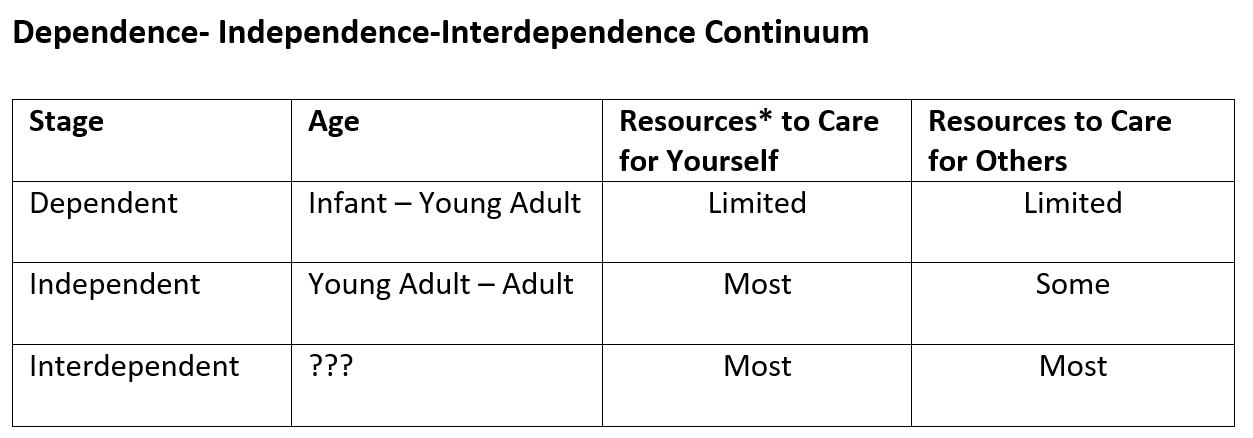
* Examples of resources include = ability to comfort, mentor, ability to pay bills, listen, do errands, make purchases, provide advice, recognize limitations, see other’s strengths and weaknesses, solve problems, maintain person and home, give grace
Practicing What We Preach
By: Beth Schaefer
[/vc_column_text]
This article discusses some of the tools we teach and use while sharing the results of our most recent survey.
Business Architecture
Our Business Architecture Certificate Program has two core components: understanding the business and moving from business strategy to execution. The survey is part of the first component of understanding our customized training clients’ needs. IPD wanted to measure if we are providing the products and services our customizers need and delivering them in a useful way. To do this, we used a process we teach in the business architecture course:
- We described the work our clients are trying to get done by outsourcing the training of their employees to The IPD.
- We described qualities of the product (The IPD training) that they found valuable.
- We described how The IPD is unique from others who offer training and maybe the reasons that our clients use us for training.
- We used the survey to verify with our clients that we had guessed correctly (or not – in some cases) about their work, their needs, and their IPD value.
- At this point, one usually writes a value proposition statement to keep their products and services focused; however, IPD already had this statement, and when our team revisited it, we verified that our value proposition statement is still accurate.
Our next step is to define our strategy and align projects to execute that strategy. As an intermediate step, I have summarized our results using a strategy we teach in our leadership courses.
Leadership Evaluation Strategy
In our Public Sector Supervision courses, we teach the use of the STOP, START, CONTINUE strategy. As a leader, when you get new information from an internal source (like a new process from finance) or an external source (like new legislation or best practice from a training workshop), the STOP, START, CONTINUE allows you to do a quick evaluation on how that new input could or should change what you currently do.
Here is what it looks like when I apply that evaluation tool to our customized training clients’ survey results.
STOP
- Spending too much time and money developing virtual/online courses for customized training. Unless our customized training clients have employees spread out at national locations, they prefer to have them gather in person for our training workshops.
- Handing out paper certificates. While this may be helpful sometimes, most are interested in acknowledging accomplishments in a more streamlined way.
START
- Using electronic badges when someone completes a stackable credential or certificate.
- Adding advanced training topics on the topics and courses we already offer.
- Figuring out how to add ongoing support after the direct training is completed and participants try to implement their new skills and learning.
CONTINUE
- Vetting and using instructors that are both knowledgeable of the topic and able to engage their audience.
- Developing training that is about the immediate application of new skills.
- Being flexible on where and when training is offered.
- Using the training proposal as both a tool to scope projects and a tool to speed up contract execution. Note: In every past survey, the contract process (8+ weeks) was listed as something we needed to improve. Thanks to this new process and a new contracts expert in the finance office, The IPD can now execute a contract with a client in 8 days.
Armed with this client information, IPD will define some long-term strategies. For instance, IPD is currently developing some courses for Diversity, Equity, and Inclusion training. As we do that, we are looking at client information to align those training features with the ones our clients need and want.
Thank you very much to the clients who took the survey and the clients who continue to support our work with repeat business and by recommending us to others!
Public Sector Hiring Challenges (and Solutions)- Part 2: Disrupt and Innovate
Public Sector Hiring Challenges (and Solutions)
[/vc_column_text]
Part 2: Disrupt and Innovate
By Beth Schaefer
IPD Director
In the previous article, I presented 6 steps you can take to give your public sector organization a recruiting edge.
This article moves from the concrete to the abstract. It is the hope of a 7th action step that is yet to be defined.
Be disruptive and innovative
While I hope the 6 action steps can assist your organization with recruitment, nothing in that list is innovative. As someone who has spent her entire career in the public sector, I find it sad that the organizations that grow and maintain our democracy are in a talent crisis. I also find it ironic that so many of our roles focus on helping people with their career pathways, yet our own public sector pathway is hidden.
I stumbled into my public sector career- perhaps like many of you. I started as a public-school teacher – which I did not even associate with being a public sector role. When I was ready to move into leadership, I kept finding that the jobs I found appealing required a Master’s degree in Public Administration. I had never even heard of that degree, but I enrolled in a program, earned the degree, and continued my public sector career in higher education.
I am fortunate that my heart for service could be supported with resources for the convoluted career pathway I took; not everyone has the same resources that I had. Once they stumble onto the public sector pathway, they may not have the resources to make that change.
This hidden pathway leads me to ask some larger questions:
- Could we be doing more to promote this career pathway?
- Are there actions we could take as a collective to promote public sector careers?
- Could we start the recruiting process in middle school or high school rather than waiting for people to stumble into a public sector career?
Let’s be a choice, not a default.
To me, the younger generation is much more focused on community and service than my 80’s generation ever was. Let’s leverage those values and show those at the start of their careers that almost every profession and almost any interest can be found in the wide array of public sector roles.
If you want to be disruptive and innovative, here are some links to organizations and events that start their industry recruiting early; maybe they will ignite a spark for the Minnesota Public Sector to collectively promote ourselves as a great career option.
Statewide Tour of Manufacturing
4 Ways to Sell Your Program at Parent-Teacher Conferences
Conferences, Job Fair coming April 25th
Southwest Minnesota Career Expo
Perhaps there is a way for us to join forces and collaboratively build the talent pool rather than compete against each other for qualified candidates.
Public Sector Hiring Challenges (and Solutions)
Part 1: Recruit
[/vc_column_text]
Compiled by Beth Schaefer
IPD Director
While almost every industry sector is suffering from the challenge of the Great Resignation, the public sector is suffering more than others. Sources report a 25% vacancy rate for government jobs – up from 13% before the pandemic.
Several factors contribute to this crisis; The Public sector is:
- Experiencing high levels of retirement
- Requiring non-essential years of experience or degrees for positions – especially since 2/3 of Americans over the age of 25 do not hold a bachelor’s degree
- Moving too slowly through the hiring process and losing candidates before the offer phase
- Losing the recruitment banner of “great benefits” as corporate benefits have caught up or surpassed government benefits
- Trailing on inflation: public sector wage growth has only been 3.4% compared to 5.5% in the private sector
Insufficient qualified candidates prompted 51% of surveyed Public Sector HR Managers to reopen and extend their recruitment period.
What is Working
The National League of Cities surveyed Public Sector Managers who could check any and as many recruitment tactics they thought produced results. Here is what the survey revealed:
16 other options received 20% or less approval from HR Managers as being effective.
6 Talent-Recruiting Actions to Find Public Sector Employees in Minnesota
For those of you who are part of Minnesota’s public sector infrastructure, here are 6 actions steps that you can take to increase the probability of hiring qualified candidates for your open positions.
1. Partner with Metro State University’s programs for Public Sector Administration Degrees.
Contact Dr. Crystal Fashant to learn more about providing capstone projects to Metro State students. This program is a win/win. Graduate students receive real-world experience and your organization gets to know a qualified potential employee.
Dr. Crystal Saric Fashant, MPNA DBA (she/her)
Associate Professor and Department Chair
Department of Public and Nonprofit Leadership, College of Community Studies and Public Affairs
651.999.5853 | crystal.fashant@metrostate.edu
2. Become a vendor at the annual Law Enforcement Opportunities (LEO) Career Fair.
Metro State partners with Hennepin Tech and a small nonprofit to host this annual career fair. Contact Mary Schober Martin, the program advisor or the link to get more information.
Mary Schober Martin (she/her)
Academic Advisor
School of Criminology and Criminal Justice (SCJ)
mary.schobermartin@metrostate.edu
3. Post jobs on Metro State’s Career Center
Current Metro State students and alumni have access to Handshake, an online recruiting platform. Use this link for Handshake information and registration. The Career Center may also be able to assist you with internships and apprenticeships – especially for roles in IT. Contact Emily Johnson, the Internship and Apprenticeship Coordinator.
Emily Johnson (she/her)
Internship and Apprenticeship Coordinator, Career Center
651.793.1513 | metrostate.edu
Emily.Johnson@MetroState.edu
Metro State Career Center Handshake
4. Grow your employees by assisting them with a defined career path.
Use these links for more information on building a career path that combines experience with education. Combine this with a re-examination of your education requirements when posting a position. Here is a sampling of links for Metro State programs – many with online options:
5. Support employees with professional development offered through Metro State IPD.
Word of mouth on how well you treat your employees will boost recruitment efforts. Plus, you can build leadership skills with those who are already have experience and knowledge specific to their roles. Use this link to check out public sector training options or contact IPD to build your own.
Metro State Professional Development
6. Join Minnesota cooperative groups that post public sector roles
Use these links to find out more about these options.
Association of Minnesota Counties
While I have provided the links and contact information, IPD is part of the Metro State team, and I would be happy to help you connect with the right person with an option(s) that work for you.
Beth.Schaefer@metrostate.edu
Pets, People, and Practices: Rethinking Bereavement Policies for a Diverse Workplace
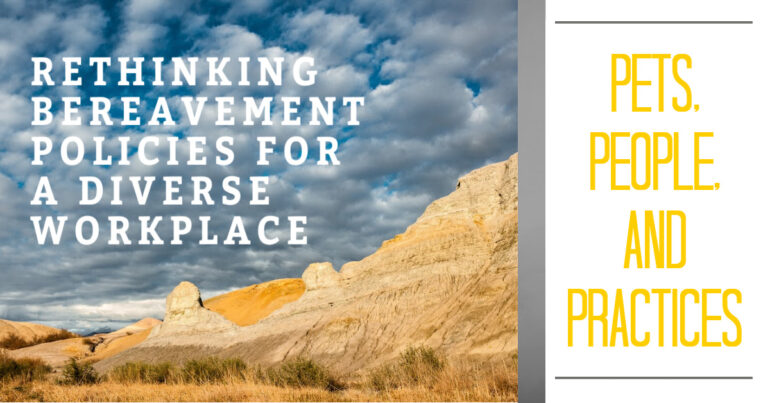
Pets, People, and Practices: Rethinking Bereavement Policies for a Diverse Workplace
By: Destyn Land
One of the most important aspects of my culture is the way we view family. While the term “immediate family” typically includes only parents, children, and siblings, my close family extends beyond these traditional boundaries. For many of us, cousins are like siblings, aunts and uncles are like second sets of parents, and our family doesn’t always fit neatly into biological relationships. This fluid concept of family is vital to understanding the importance of diversity, equity, and inclusion (DEI) policies in the workplace.
If we look closely enough and put on a different lens, we often will discover gaps between policy and practice. Despite organizations having policies that promote diversity, equity, and inclusion, it’s essential to assess their effectiveness in practice. For instance, even if a company has a policy on using inclusive language, it doesn’t necessarily guarantee the eradication of discriminatory language in the workplace. To create a supportive and safe work environment where all employees feel valued, the voices and experiences of marginalized individuals should be genuinely listened to and taken seriously. Action is necessary when employees from marginalized communities share how they’ve been harmed to strengthen the company’s commitment to DEI.
One area where DEI policies often fall short is in bereavement policies. The average bereavement policy gives a certain number of days off for the death of parents, siblings, children, grandparents, grandchild, extended family members, and close friends. However, there are potential gaps in this policy.
Broadening our understanding of family is the first step.
- For many of us, family is not limited to biological relationships. There are many people within the LGBT+ community whose biological family has caused them harm, and now they no longer keep in touch with some of them. They still may have what is often referred to as “chosen family,” individuals who are as close to them as any biological family member. When a bereavement policy defines who an employee’s “close family” is, it erases the fluidity of family that exists for many people. Chosen family members are just as much family as biological family members, and a bereavement policy should reflect that. Additionally, some pet owners consider their pets as family members, and bereavement policies should include them too.
- Have you thought about whether your bereavement policy includes pets? As someone who didn’t grow up with pets, I didn’t initially appreciate how significant losing a pet could be for some people who consider them family members. However, my perspective shifted after my close friend’s dog of 16 years passed away. Listening to their stories, I realized that the dog had been a source of emotional support throughout tough times. Unfortunately, their employer didn’t allow bereavement to leave for pets, which had a negative impact on both their mental health and job performance. It’s essential to recognize that pets can hold a significant place in employees’ lives and to offer appropriate support during times of mourning.
Another vital aspect of bereavement policies is recognizing that mourning practices look different across cultures.
- When someone dies, the grieving process can vary greatly across cultures. For some individualistic societies, mourning is prepping for a service or memorial of some kind, and then after the service life resumes as normal. However, for some cultures, mourning can extend far beyond this. For example, when my partner’s family member passed away, in their culture every family member spends time at the eldest member of the family’s home from the day of death, until the day of the funeral. My partner and her family spent the night there close to every night, sitting together, sharing memories, cooking food, and grieving as a community. While there is no one-size-fits-all solution for dealing with loss, bereavement policies need to respect the fact that different cultures have diverse customs, rituals, and practices surrounding death.
You may be questioning, is this too open-ended, and too easy for people to misuse or abuse? Despite the seeming disadvantage associated with such policies, it’s essential to consider cultural nuances where personal needs differ from one another. The goal of equity is not fairness, but rather it’s about having what every person needs.
While there is always room for someone to game the system, constant lies about the death of a family member or friend to get time off point to a much deeper issue with the company culture that needs addressing. Instead, writing the policy in a way that accommodates some level of nuance while still setting guidelines is the way to go. For instance, the policy could include a guideline indicating the number of days available for bereavement leave. The policy can also acknowledge that people process grief differently and that cultural backgrounds play a role in how people react to grief. The policy may state, “We recognize that grief impacts people differently, and different cultures have different norms for grieving. If, for any reason, an employee needs extended bereavement leave beyond the given number of days, they can contact Human Resources or their direct supervisor.”
The goal should be flexibility rather than rigidity. The work of Diversity, Equity, and Inclusion demands us to think and act beyond our comfort zones in specific situations, making it crucial to keep questioning and brainstorming new solutions. Being risk-averse is okay, but it’s equally important to embrace possibilities for making workplaces more supportive for everyone.
While there may be many concerns about bereavement policies, ensuring employees can grieve and come back to work ready to be productive is essential for a company’s health and longevity. Writing policies in ways that accommodate nuances while reinforcing guidelines is a right step in the goal of creating a workplace where everyone has what they need to thrive.



